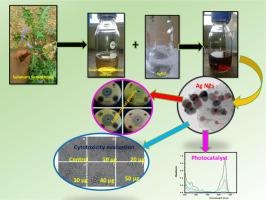当前位置:
X-MOL 学术
›
Inorg. Chem. Commun.
›
论文详情
Our official English website, www.x-mol.net, welcomes your feedback! (Note: you will need to create a separate account there.)
Environmental and Biomedical Applications of AgNPs Synthesized Using the Aqueous Extract of Solanum surattense Leaf
Inorganic Chemistry Communications ( IF 3.8 ) Pub Date : 2020-11-01 , DOI: 10.1016/j.inoche.2020.108228 M. Mani , J.H. Chang , A. Dhanesh Gandhi , D. Kayal Vizhi , S. Pavithra , K. Mohanraj , B. Mohanbabu , B. Babu , S. Balachandran , S. Kumaresan
Inorganic Chemistry Communications ( IF 3.8 ) Pub Date : 2020-11-01 , DOI: 10.1016/j.inoche.2020.108228 M. Mani , J.H. Chang , A. Dhanesh Gandhi , D. Kayal Vizhi , S. Pavithra , K. Mohanraj , B. Mohanbabu , B. Babu , S. Balachandran , S. Kumaresan

|
Abstract A novel eco-friendly and biocompatible method has been used with the help of Solanum surattense aqueous leaves extract to synthesis silver nanoparticles (AgNPs). The cost-effective green synthesis route has been given much care to ensure an environmentally friendly and straightforward approach, as it is most demanded in the biomedical industry. The proposed novel synthesis method offers additional compensations over other synthesizing approaches. Different analytical systems such as UV–vis, IR, XRD, DLS, SEM, EDAX, XPS, and TEM characterization techniques were used to understand the quality of the green synthesized nanoparticles for biomedical applications. The surface plasmon resonance peak of green synthesized silver nanoparticles at 446 nm was observed by UV absorbance spectral analysis. The XRD, SEM, and TEM analysis using to study the crystal structure, particle size, and surface morphology of the AgNPs. The results confirmed the synthesized spherical shape silver nanoparticles were crystallized in a face-centered cubic structure. The zeta potential measurement was used to authorize the excellent stability of AgNPs employing the dynamic light scattering method. FTIR spectral study confirmed that phytocompound participate in the bioreduction as well as stabilization of biosynthesized AgNPs by Solanum surattense. Also, the phytochemical content acts as the capping agent on surface AgNPs. The synthesized silver nanoparticles are subjected to antibacterial activity against both gram-positive and negative pathogenic bacteria for finding suitability in biocompatible applications. Also, the cytotoxicity of AgNPs was studied against the human breast cancer cell line and compared with one of the commercially available cancer drugs. Also, we have shown that the prepared AgNPs could serve as an excellent photocatalyst for degrading the Rhodamine B (RhB) dye and Acid Violet 7 (AV 7) dye under direct sunlight radiation.
中文翻译:

用茄叶水提物合成的 AgNPs 的环境和生物医学应用
摘要 一种新型的生态友好和生物相容性方法已在茄属植物水叶提取物的帮助下合成银纳米粒子 (AgNPs)。具有成本效益的绿色合成路线得到了很多关注,以确保采用环保和直接的方法,因为它是生物医学行业最需要的。与其他合成方法相比,所提出的新型合成方法提供了额外的补偿。使用不同的分析系统,如 UV-vis、IR、XRD、DLS、SEM、EDAX、XPS 和 TEM 表征技术来了解用于生物医学应用的绿色合成纳米粒子的质量。通过紫外吸收光谱分析观察到绿色合成银纳米粒子在 446 nm 处的表面等离子体共振峰。XRD、SEM、和 TEM 分析用于研究 AgNPs 的晶体结构、粒径和表面形态。结果证实合成的球形银纳米颗粒以面心立方结构结晶。zeta 电位测量用于验证采用动态光散射方法的 AgNPs 的出色稳定性。FTIR 光谱研究证实植物化合物参与了 Solanum surattense 对生物合成的 AgNPs 的生物还原和稳定。此外,植物化学成分可作为表面 AgNP 的封端剂。合成的银纳米粒子对革兰氏阳性和阴性致病菌均具有抗菌活性,以发现其在生物相容性应用中的适用性。还,研究了 AgNPs 对人乳腺癌细胞系的细胞毒性,并与其中一种市售抗癌药物进行了比较。此外,我们已经表明,制备的 AgNPs 可以作为一种极好的光催化剂,用于在阳光直射下降解罗丹明 B (RhB) 染料和酸性紫罗兰 7 (AV 7) 染料。
更新日期:2020-11-01
中文翻译:

用茄叶水提物合成的 AgNPs 的环境和生物医学应用
摘要 一种新型的生态友好和生物相容性方法已在茄属植物水叶提取物的帮助下合成银纳米粒子 (AgNPs)。具有成本效益的绿色合成路线得到了很多关注,以确保采用环保和直接的方法,因为它是生物医学行业最需要的。与其他合成方法相比,所提出的新型合成方法提供了额外的补偿。使用不同的分析系统,如 UV-vis、IR、XRD、DLS、SEM、EDAX、XPS 和 TEM 表征技术来了解用于生物医学应用的绿色合成纳米粒子的质量。通过紫外吸收光谱分析观察到绿色合成银纳米粒子在 446 nm 处的表面等离子体共振峰。XRD、SEM、和 TEM 分析用于研究 AgNPs 的晶体结构、粒径和表面形态。结果证实合成的球形银纳米颗粒以面心立方结构结晶。zeta 电位测量用于验证采用动态光散射方法的 AgNPs 的出色稳定性。FTIR 光谱研究证实植物化合物参与了 Solanum surattense 对生物合成的 AgNPs 的生物还原和稳定。此外,植物化学成分可作为表面 AgNP 的封端剂。合成的银纳米粒子对革兰氏阳性和阴性致病菌均具有抗菌活性,以发现其在生物相容性应用中的适用性。还,研究了 AgNPs 对人乳腺癌细胞系的细胞毒性,并与其中一种市售抗癌药物进行了比较。此外,我们已经表明,制备的 AgNPs 可以作为一种极好的光催化剂,用于在阳光直射下降解罗丹明 B (RhB) 染料和酸性紫罗兰 7 (AV 7) 染料。



























 京公网安备 11010802027423号
京公网安备 11010802027423号